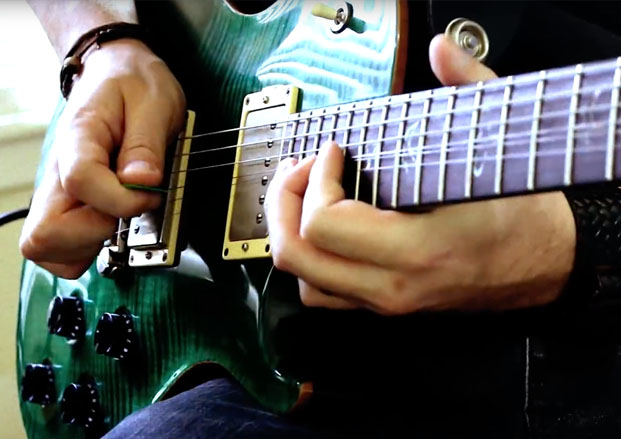Tips on Creating a Guitar Practice Schedule
Learn how to mold your practice routine to fit your specific playing needs.

How would you respond to this question: “What’s the hardest thing you know on guitar?”
Some people might whip out their flashiest sweep-picking lick. Others may show off their slickest two-handed tapping pattern. Those are both valid replies, but when I was asked that question by one of my Guitar Super System students, I had a different answer.
The hardest thing I know on guitar is how to practice. This skill didn’t come overnight, but it’s something I consider to be the hardest learnings to absorb as a guitar player. We’ve all done it—we sit down to run our scales, but after about three minutes, we’re on YouTube looking up a sick metal backing track to solo over.
There’s no shame in this; in fact, it’s necessary to let loose from time to time and enjoy yourself on your instrument. The key is learning to channel that urge to shred and keep it from interfering with progress. The skill and discipline of practicing proficiently is vital to your continued development as a guitar player, so in this lesson, I’ll outline how I recommend you create a guitar practice schedule. My approach consists of customizable elements that allow you to cater the routine to your own musical goals, because there is no one-size-fits-all curriculum. This layout is a based on the philosophies of guitar lords like Steve Vai and Paul Gilbert, as well as what I’ve seen be most effective for students in my experience as a guitar teacher.
STEP ONE is deciding how much time you’ll commit to practicing each day. It’s highly encouraged that you practice every single day, but the most important thing is dedicating an allotted amount of minutes or hours to a consistent schedule. If you falter from the routine, you won’t improve nearly as quickly. For the purpose of this lesson, let’s say you choose an hour and a half of practice time per day.
STEP TWO is to then break that time into categories of practice. I’ll outline the categories I recommend, as they’re pretty universal and will be customized in the next step. The categories are: Exercises, Scales, Chords, Ear Training, Sight Reading, Theory, Songwriting, and Improvisation. I’ve chosen to spend 15 minutes on each category per practice session, which of course would give us two hours of potential practice, going over the hour and a half timeframe I decided in. This is where the customization begins.
I’ll throw out two categories per session, meaning I won’t practice two of the eight categories on a given day. The next day, however, I have to be sure to hit those categories. So if one day I exclude Theory and Improvisation, I’ll be required to practice those categories the following day. The customization continues in the last step.
THE THIRD AND FINAL STEP is to customize the categories to your guitar goals. The exercises category can consist of any exercises that will help you achieve your desired results. If you want to be come a better metal player, insert sweeping, tapping and alternate picking exercises here. There are plenty of these types of exercises on Guitar World to choose from. If you want to become a better funk player, you could add rhythmic chord vamps over drum loop exercises, among many others. For the scales category, you might want to focus on the Mixolydian and symmetrical diminished scales for blues, but harmonic minor for hard rock. As you can see, there's no limit to the way you can mold these categories to your satisfaction—the key is that you commit to the schedule once you’ve built it. If you do, your devotion will pay off in a remarkable way in just a short period of time.
Tyler Larson is the founder of the guitar-centric brand Music is Win. His insightful, uncomplicated guitar lessons and gear demonstrations along with entertaining, satirical content about life as a musician receive tens of millions of video views per month across social media. Tyler is also the creator of the extremely popular online guitar learning platform, Guitar Super System. A graduate of Berklee College of Music, Tyler has been teaching guitar for over a decade and operates a production studio in Nashville, TN.
Get The Pick Newsletter
All the latest guitar news, interviews, lessons, reviews, deals and more, direct to your inbox!
Tyler Larson is the founder of the guitar-centric brand Music is Win. His insightful, uncomplicated guitar lessons and gear demonstrations along with entertaining, satirical content about life as a musician receive tens of millions of video views per month across social media. Tyler is also the creator of the extremely popular online guitar learning platform, Guitar Super System. A graduate of Berklee College of Music, Tyler has been teaching guitar for over a decade and operates a production studio in Nashville, TN.
“There are so many sounds to be discovered when you get away from using a pick”: Jared James Nichols shows you how to add “snap, crackle and pop” to your playing with banjo rolls and string snaps
Don't let chord inversions bamboozle you. It's simply the case of shuffling the notes around







![Joe Bonamassa [left] wears a deep blue suit and polka-dotted shirt and plays his green refin Strat; the late Irish blues legend Rory Gallagher [right] screams and inflicts some punishment on his heavily worn number one Stratocaster.](https://cdn.mos.cms.futurecdn.net/cw28h7UBcTVfTLs7p7eiLe.jpg)


